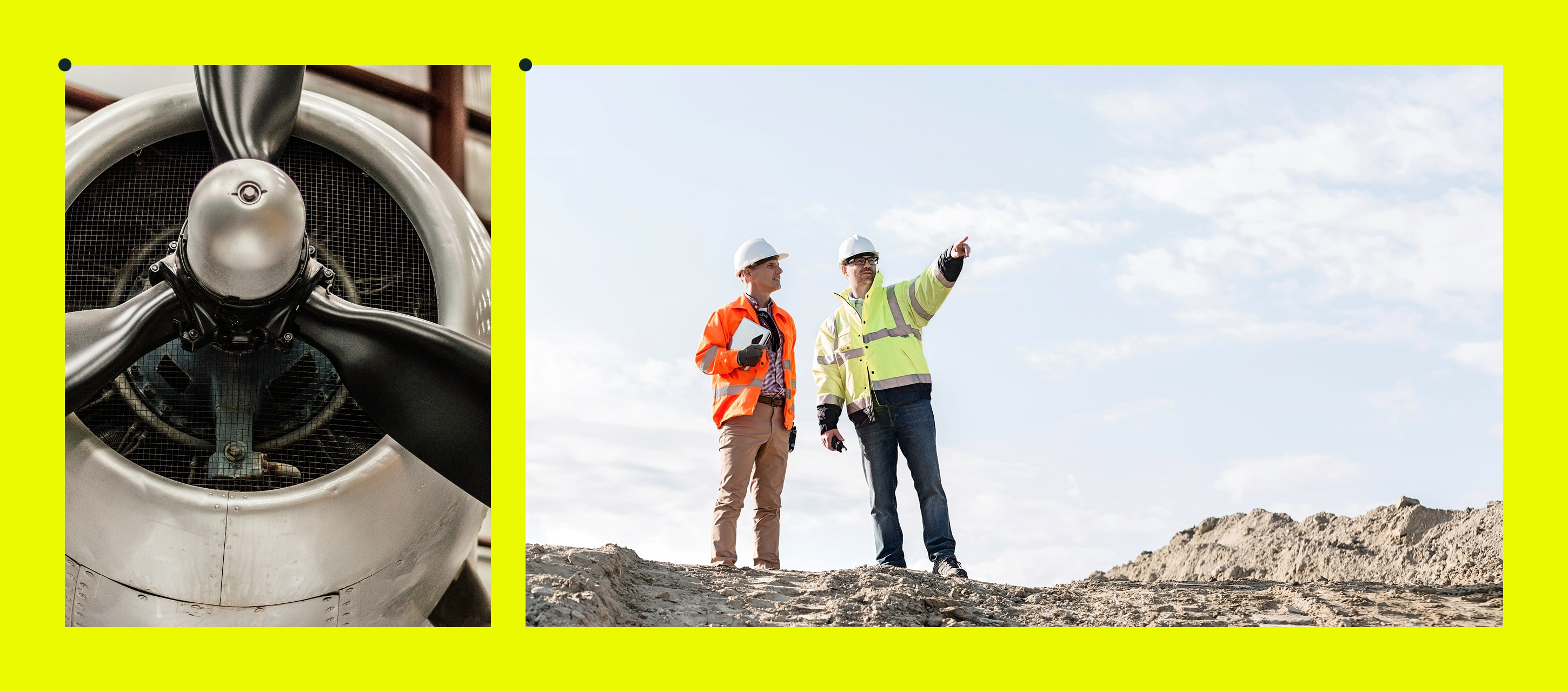If you work in the field, you know change doesn’t happen overnight. You’re balancing outdated systems, unpredictable schedules, and increasing demands for efficiency.
But in 2025, things are shifting – fast. AI, automation, and digital tools are set to make field work smarter, faster, and safer. The question is: Are you ready?
At Fluix, we’ve been tracking the shifts ahead. Our team has identified 10 key trends to help you stay prepared for what’s next.
Contents:
1. AI Agents
When Microsoft CEO Satya Nadella in a recent interview on the BG2 Podcast suggested that traditional business applications could be replaced by AI agents, the tech world took notice. Some even called it “the death of SaaS as we know it.” After all, if AI agents can anticipate requests and interact naturally with people, why would businesses rely on rigid software?
That said, field service industries aren’t likely to dive headfirst into the Agents as a Service (AaaS) era just yet. Legacy systems are deeply embedded in their operations. However, AI’s growing role in how frontline teams interact with technology is undeniable.
Imagine this: AI-powered assistants act as digital co-pilots for technicians, analyzing data, offering real-time insights, and automating decision-making. They help troubleshoot equipment failures, provide hands-free access to critical documentation, and even suggest optimal repair methods. Ambitious? Maybe. Feasible? In some cases already happening.
Key Considerations
- Ethical concerns
- Integration with legacy systems
- Data reliability
- AI governance and cybersecurity measures
- The role of human judgment
- Scalability and cost-effectiveness
2. Hyperautomation
The concept of hyperautomation took off in 2019, when Gartner named it one of the top strategic technology trends. Think of it as automation on steroids that includes a mix of AI, machine learning, IoT & smart sensors, robotic process automation (RPA), and digital twin technology to create highly intelligent systems.
Fast forward to 2025, and while industries have made significant moves, full-scale adoption remains a work in progress. Yes, construction has embraced AI-driven scheduling and compliance tracking, energy and utilities rely on smart grids and predictive maintenance, and manufacturing optimizes production lines using IoT sensors and RPA.
Yet, the vision of fully integrated, autonomous operations without human involvement is still far from reality. For field service industries in particular, hyperautomation will remain a critical trend for years to come.
Key Considerations
- Adoption of AI-powered tools
- Digital Twins for simulation
- Integration with existing systems
- Data security and compliance
- Cost vs. ROI analysis
- Training and buy-in from employees
- Scalability and cost-effectiveness
3. Predictive Analytics for Safety Management
Predictive analytics isn’t new. For several years, industries have used it to analyze historical data, spot patterns, and anticipate potential safety risks. Why it becomes an often topic of safety conversations in 2025 is because technology is catching up to its full potential.
Now, with IoT sensors, AI-driven analytics, and real-time monitoring tools, companies can predict hazards earlier (instead of just reacting to them). Equipment failures, environmental risks, and worker fatigue can be detected before they become critical.
And with stricter safety regulations emerging worldwide, businesses face growing pressure to adopt predictive systems to avoid penalties in the first place.
Some industries are leading the way. For example, aviation is using predictive analytics to track crew activity and rest phases, helping airlines assess fatigue risks and adjust flight schedules. This approach is part of a broader push to prevent burnout and enhance occupational safety in high-stress roles.
Key Considerations
- Data reliability
- System integration
- Actionable insights, not just alerts
- Data transparency and compliance
- Training and adoption
4. Digital Twins
Not everyone is familiar with the term, so let’s start with the definition. A digital twin is a virtual replica of a physical asset, system, or process, continuously updated with real-world data. It uses IoT sensors, AI, and predictive analytics to provide insights that help businesses maintain equipment and reduce risk.
Industries like manufacturing, energy, and utilities are already putting digital twins to work. Wind farm operators, for example, create digital models of turbines to track performance, spot wear, and fine-tune energy output. In construction, digital twins map out a building’s entire lifecycle, helping teams predict maintenance needs and manage resources more efficiently.
But adoption isn’t seamless. Cost, integration challenges, and the need for specialized expertise slow down implementation. Still, as AI and IoT technology improve, digital twins are becoming more practical and scalable – and adjusted to complex operations.
Key Considerations
- Integration with IoT and AI
- Data accuracy
- Cybersecurity risks
- Long-term efficiency
- Scalability
5. Adaptive Scheduling and Dispatch
Traditional methods no longer fit today’s pace. A smarter approach of adaptive scheduling is taking hold, using real-time data, telematics, and artificial intelligence to allocate tasks dynamically.
It can constantly recalculate assignments based on technician availability, skill sets, job priority, and even current traffic conditions. The biggest shift isn’t just in technology itself though. It’s in how decisions get made.
While traditional schedules rarely change, adaptive scheduling updates in real time, adjusting as new information comes in. While dispatchers used to spend hours handling assignments manually, AI-driven systems now optimize routes and workloads automatically. While the old approach considered availability, the new one factors in location, expertise, past job performance, and real-time conditions.
Not every field team may need this. But if your work involves urgent, location-based tasks – like utilities, field maintenance, telecommunications, or home healthcare – real-time dispatch will soon become critical.
Key Considerations
- Change management
- Connectivity in remote locations
- Technician workload balance
- Emergency response handling
- Inventory management
- Data accuracy
6. Route Optimization
Optimizing routes has always been a priority in field service. Travel is one of the biggest cost factors – fuel, vehicle wear and tear, and non-billable technician hours all add up.
The longer technicians spend on the road, the less time they have for actual work. There’s also the hidden cost of dispatch inefficiencies, where manual scheduling leads to wasted trips and poorly planned assignments.
That’s why businesses have long sought ways for improvement. And now, thye have all cards on hands with solutions booming. According to Global News Wire, the route optimization software market is projected to grow at a 17.9% CAGRthrough 2030, reaching $21.7 billion.
What does this mean in practice? Different things actually, based on your sector.
For wind farm management, AI-powered route planning can schedule maintenance visits in the most efficient order, considering factors like technician proximity, turbine downtime risk, and weather conditions. For emergency repairs, the system dynamically routes technicians based on real-time outage reports, road conditions, and availability. For broadband providers, jobs are clustered by location. The options are plenty.
Key Considerations
- Integration with existing dispatch systems
- Route recalculation
- Skill-based assignments
- Fleet coordination
- Customer communication
- Offline functionality
7. Wearable Technology
While the first wave of wearable technology was often bulky and had basic real-world applications, today’s wearables are no longer a futuristic concept – they’re here, and they’re making a difference.
Airline maintenance crews at Lufthansa Technik use AR-enabled smart glasses to inspect aircraft components. The global chemical company BASF deploys smart helmets with built-in AR displays that help plant inspectors ensure compliance with safety protocols. Ford’s assembly lines use biometric wearables to monitor employees’ movements, helping to prevent repetitive strain injuries.
And innovation isn’t slowing down. Startups are pushing the boundaries of what wearables can do. US-based Verve Motion develops robotic exosuits to support workers involved in heavy lifting, while Canadian startup SolusGuard offers wearable panic buttons for lone workers in high-risk environments. And this list goes on.
Key Considerations
- Connection with existing systems
- Data encryption and access controls
- User comfort and adoption
- Durability and field readiness
- Offline functionality
- Cost vs. ROI
8. AR and VR Tools
According to Research and Markets, augmented and virtual reality (AR/VR) technologies were expected to see the fastest growth by 2025. But looking at the current landscape, that timeline might be a bit optimistic. While adoption is certainly rising, the real transformation in field service industries could take several more years.
Technicians now use AR glasses for real-time guidance, overlaying instructions onto their field of view. VR offers immersive training, allowing workers to practice procedures safely. These tools help specialists diagnose issues remotely, cutting travel time and boosting first-time fix rates.
Still, adoption isn’t seamless. Many companies rely on legacy systems that don’t integrate easily with AR/VR. High costs, connectivity gaps, and the need for specialized training remain barriers. While advances like Microsoft’s HoloLens 2 and 5G improve accessibility, integrating these technologies requires significant investment. Maybe, 2025 will be a game-changer.
Key Considerations
- System compatibility
- Training and user adoption
- Connectivity and offline capabilities
- Security and data privacy
- Wearability and comfort
9. Technical Enablement
One of the newest trends we see. With the rise of tech usage on the job sites, traditional training alone isn’t enough, and field teams start to require access to knowledge, digital tools, and AI-driven support.
The concept is still evolving. But it will most likely incorporate interactive platforms, AR-based remote support, mobile-first training, and AI-driven diagnostics. Real-time communication tools are also growing, as people still prefer learning from people first.
What you can do to prepare is to consider investing in AI-powered knowledge bases, upgrading technician devices, digitizing maintenance workflows, and encouraging knowledge sharing.
Siemens, for example, is taking their predictive maintenance to a new level by integrating generative AI into its Senseye Predictive Maintenance platform. By using a conversational user interface (UI), manufacturers can engage in interactive dialogues with the AI to streamline decision-making and improve accuracy.
Key Considerations
- Accessibility and usability
- Remote support capabilities
- Video-calls for guided repairs
- AR overlays support
- Cybersecurity threats
10. Global Net Zero Commitments
The push for net zero carbon emissions is forcing companies to rethink operations, energy use, and workforce efficiency. In construction, the pressure is particularly high – by 2050, all buildings, infrastructure, and renovations must meet net zero embodied and operational carbon standards.
Organizations like the World Green Building Council, UK Green Building Council (UKGBC), Royal Institute of British Architects (RIBA), and the American Institute of Architects (AIA) are driving the effort. But this shift isn’t just about buildings. Every industry with field teams will need to adjust.
Your team won’t just be repairing equipment or installing systems – you’ll be expected to do it in ways that cut emissions and improve efficiency. That means rethinking site visits, using energy-efficient assets, optimizing fleet operations and reducing waste on the job.
AI-powered monitoring systems are expected to help field teams track usage, reduce waste, and optimize energy consumption in real time. Yet, the extent of their impact remains to be seen.
Key Considerations
- Emissions impact
- Regulatory flexibility
- Sustainability-focused tools
- Workforce training
- Cost vs. savings
Final Thoughts
In 2025, AI tools, sustainability goals, and human communication will continue to shape all field service sectors. The key to balancing innovation with practical implementation is flexibility and strategic adoption of digital solutions that truly enhance efficiency.
Long-term planning may feel uncertain in such a fast-moving landscape, but one thing is clear: companies embracing digital transformation will stay ahead of the curve.






